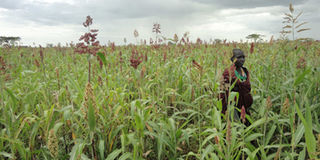Vitamin A-rich millet to be developed by researchers

Packaging staple food crops like millet with essential nutrients is a low-cost sustainable way to combating malnutrition and related deficiencies especially among those that are most vulnerable like children and women. File Photo.
What you need to know:
Ugandan reseachers are in the process of developing millet types that will have vitamin content on top of the iron it provides in a bid to combat nutrition deficiencies.
Do you want millet packed with essential nutrients that will boost your health? Millet farmers will soon have a variety, which contains Vitamin A in their fields. Crop scientists from National Semi-Arid Resources Research institute have developed a number of varieties, which are tolerant to drought as well as pest and disease infection.
High yield potential
The pearl millet varieties that have been released to farmers include Serere1 and Serere2, which mature within 90 days and yield up to 2,500kg per hectare. Varieties like Serem1 and Serem2 ,which grow in dry regions such as Karamoja have also been released, though Serem3 is good for mid-altitude areas.
These varieties were developed using the conventional method although scientists at the National Research Laboratories Institute in Kawanda are exploring means of developing varieties that contain Vitamin A using biotechnology.
Dr Geoffrey Arinaitwe, the team leader for the project, says the objective of coming up with this variety will help solve health problems associated with Vitamin A deficiency. It is expected that loading a staple food like millet with this vital nutrient will help improve sight as well as maternal health.
Millet is a source of iron, the reason why it is recommended for children and pregnant mothers. However, the iron content alone is not sufficient enough to deal with such as malnutrition in children and anaemia in pregnant mothers therefore the need to incorporate the micronutrient, Vitamin A, into the crop.
“One of the main reasons as to why pregnant mothers eat soil is because their body lacks iron and Vitamin A. To prevent them from craving soil which may end up being disastrous to their health, we need to breed crop varieties rich with food nutrient,” Dr Arinaitwe said.
Getting good genes
The research team has finished with stage one of the breeding process where they developed millet from cells of the improved millet varieties from Serere. The process of generating these cells was done in the laboratory. After leaving the cells to grow for a period of two to three weeks, they are transferred to a greenhouse for further growth.
The second stage will be obtaining genes from the traditional maize variety with Vitamin A. The genes will be transferred to the millet in the laboratory using gene sequencing.
The breeding has been going on for the last two years and the team needs about four more years to come up with a millet variety that contains both iron and vitamin A.
The scientists have also taken the initiative to train farmers in better agronomic practices that would be used to produce high quality millet.
NaSARRI, in collaboration with an organisation called Harnessing Opportunities for Productivity Enhancement (HOPE), have led the formation of farmer groups in Ikiere Sub county, Serere district to enhance awareness in millet growing techniques.
Charles Oile and Zeblalon Ejomu, who are some of the group members, said that during the April-July 2011 cropping season, following trainings by the National Agricultural Advisory Services, a total of 12 tonnes of Seremi2 seed was produced by six affiliate groups. This seed is intended for further upscaling and adoption by other farmers.
A farmer, John Oonyu, 70, who owns three acres of farmland and has a 13-member household, testifies that he harvested 200kg of Seremi2 seed on half an acre. He attributes this to sensitisation on good finger millet agronomy practices.




